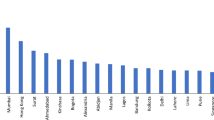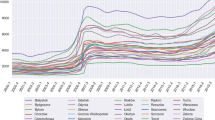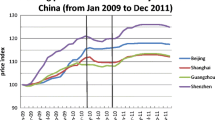Abstract
House prices in China have increased greatly in recent decades, and the dynamics seem to vary across cities. It is rational to assume that urban housing prices converge to different equilibria and form club convergence (i.e., subgroups). Empirical evidence on the existence of club convergence is limited, however, as is evidence on the underlying mechanisms. Therefore, the aim of the present study was to 1) detect club convergence in housing prices across Chinese regions over the period 2006–17 and 2) examine the determinants influencing club formation. A log t test in combination with a clustering algorithm was used to assess club formation. The results showed that regional housing prices face heterogeneous dynamics, providing some evidence of housing market segmentation. Four convergence clubs of Chinese regions with different convergence levels were identified. Ordered logit model showed that population growth, income, and housing regulation are among the drivers of club formation. The results also indicated that being in a different Chinese city-tier and differences in urban healthcare affect housing market club membership. The findings are supportive for policymakers to coordinate balanced regional housing development across China.






Similar content being viewed by others
Notes
Areas in the east show significantly higher house prices than those in central or western China and cities being ranked high in Chinese city-tier have higher housing prices and growth.
To circumvent spurious dynamic relations in a traditional HP filter, Hamilton (2018) proposed using an OLS regression of variable g on a constant and the p lag term of g (the value p depends on the date type). The fitted values are used as an estimate of the latent cyclical component.
For house price index data, when the first time of the observation is set as the base year, one trend component will appear for the calculated data because of the influence of the same initial condition.
5 We discarded a fraction (v = 0.2) of the time series in terms of the size (T = 95, > 50). Setting v = 0.22, 0.24, 0.26 and 0.30 was used to check for robustness.
References
Abbott A, Vita GD (2012) Pairwise convergence of district-level house prices in London. Urban Stud 49(4):721–740
Abbott A, Vita GD (2013) Testing for long-run convergence across regional house prices in the UK: a pairwise approach. Appl Econ 45(10):1227–1238
Alexander C, Barrow M (1994) Seasonality and cointegration of regional house prices in the UK. Urban Stud 31(10):1667–1689
Apergis N, Payne JE (2012) Convergence in US house prices by state: evidence from the club convergence and clustering procedure. Lett Spat Resour Sci 5(2):103–111
Apergis N, Simo-Kengne BD, Gupta R (2015) Convergence in provincial-level South African house prices: evidence from the club convergence and clustering procedure. Rev of Urban Reg Dev Stud 27(1):2–17
Awaworyi Churchill S, Inekwe J, Ivanovski K (2018) House price convergence: evidence from Australian cities. Econ Lett 170:88–90. https://doi.org/10.1016/j.econlet.2018.06.004
Barro RJ, Sala-i-Martin X (1992) Convergence. J Polit Econ 100(2):223–251
Barros CP, Gil-Alana LA, Payne JE (2012) Comovements among U.S. State housing prices: evidence from fractional cointegration. Econ Model 29(3):936–942. https://doi.org/10.1016/j.econmod.2012.02.006
Baumol WJ (1986) Productivity growth, convergence, and welfare: What the long-run data show. The American Economic Review 1072–1085
Blanco F, Martín V, Vazquez G (2016) Regional house price convergence in Spain during the housing boom. Urban Stud 53(4):775–798
Carlino GA, Mills LO (1993) Are US regional incomes converging?: A time series analysis. J Monet Econ 32(2):335–346
Chenery HB, Robinson S, Syrquin M, Feder S (1986) Industrialization and growth: Citeseer
Cook S (2003) The convergence of regional house prices in the UK. Urban Stud 40(11):2285–2294
Cook S (2005) Detecting long-run relationships in regional house prices in the UK. Int Rev Appl Econ 19(1):107–118
Cook S (2012) β-convergence and the cyclical dynamics of UK regional house prices. Urban Stud 49(1):203–218
Du K (2017) Econometric convergence test and club clustering using Stata. Stata J 17(4):882–900
Gong Y, Hu J, Boelhouwer PJ (2016) Spatial interrelations of Chinese housing markets: Spatial causality, convergence and diffusion. Reg Sci Urban Econ 59:103–117
Gray D (2018) Convergence and divergence in British housing space. Reg Stud 52(7):901–910. https://doi.org/10.1080/00343404.2017.1360480
Grigoryeva I, Ley D (2019) The price ripple effect in the Vancouver housing market. Urban Geogr 40(8):1168–1190. https://doi.org/10.1080/02723638.2019.1567202
Hamilton JD (2018) Why you should never use the Hodrick-Prescott filter. Rev Econ Stat 100(5):831–843
Hodrick RJ, Prescott EC (1997) Postwar US business cycles: an empirical investigation. J Money Credit Bank 29(1):1–16
Holly S, Hashem Pesaran M, Yamagata T (2011) The spatial and temporal diffusion of house prices in the UK. J Urban Econ 69(1):2–23. https://doi.org/10.1016/j.jue.2010.08.002
Holmes MJ, Grimes A (2008) Is there long-run convergence among regional house prices in the UK? Urban Stud 45(8):1531–1544
Holmes MJ, Otero J, Panagiotidis T (2011) Investigating regional house price convergence in the United States: Evidence from a pair-wise approach. Econ Model 28(6):2369–2376
Holmes MJ, Otero J, Panagiotidis T (2017) A pair-wise analysis of intra-city price convergence within the Paris housing market. J Real Estate Financ Econ 54(1):1–16
Holmes MJ, Otero J, Panagiotidis T (2018) Climbing the property ladder: an analysis of market integration in London property prices. Urban Stud 55(12):2660–2681
Holmes MJ, Otero J, Panagiotidis T (2019) Property heterogeneity and convergence club formation among local house prices. J Hous Econ 43:1–13. https://doi.org/10.1016/j.jhe.2018.09.002
Kim YS, Rous JJ (2012) House price convergence: evidence from US state and metropolitan area panels. J Hous Econ 21(2):169–186. https://doi.org/10.1016/j.jhe.2012.01.002
Lee CC, Chien MS (2011) Empirical modelling of regional house prices and the ripple effect. Urban Stud 48(10):2029–2047. https://doi.org/10.1177/0042098010385257
Lee CC, Lee CC, Chiang SH (2016) Ripple effect and regional house prices dynamics in China. Int J Strateg Prop Manag 20(4):397–408
Liu T-Y, Su C-W, Chang H-L, Chu C-C (2018) Convergence of regional housing prices in China. J Urban Plan Dev 144(2):04018015
Mao G (2016) Do regional house prices converge or diverge in China? China Econ J 9(2):154–166. https://doi.org/10.1080/17538963.2016.1164493
McKelvey RD, Zavoina W (1975) A statistical model for the analysis of ordinal level dependent variables. J Math Sociol 4(1):103–120
Meen G (1999) Regional house prices and the ripple effect: a new interpretation. Hous Stud 14(6):733–753
Meen G (2002) The time-series behavior of house prices: a transatlantic divide? J Hous Econ 11(1):1–23
Meen G (2016) Spatial housing economics: a survey. Urban Stud 53(10):1987–2003
Montagnoli A, Nagayasu J (2015) UK house price convergence clubs and spillovers. J Hous Econ 30:50–58
Montañés A, Olmos L (2013) Convergence in US house prices. Econ Lett 121(2):152–155. https://doi.org/10.1016/j.econlet.2013.07.021
Phillips PC, Sul D (2007) Transition modeling and econometric convergence tests. Econometrica 75(6):1771–1855
Phillips PC, Sul D (2009) Economic transition and growth. J Appl Economet 24(7):1153–1185
Quah D (1992) International patterns of growth: I. Persistence in Cross-country Disparities, Unpublished manuscript, London School of Economics
Rong Z, Wang W, Gong Q (2016) Housing price appreciation, investment opportunity, and firm innovation: evidence from China. J Hous Econ 33:34–58
Rostow WW (1980) Why the poor get richer and the rich slow down: Essays in the Marshallian long period: Springer
Schnurbus J, Haupt H, Meier V (2017) Economic transition and growth: a replication. J Appl Economet 32(5):1039–1042
Tsai I-C (2018a) House price convergence in euro zone and non-euro zone countries. Econ Syst 42(2):269–281
Tsai IC (2018b) Housing price convergence, transportation infrastructure and dynamic regional population relocation. Habitat Int 79:61–73. https://doi.org/10.1016/j.habitatint.2018.07.004
Wen H, Tao Y (2015) Polycentric urban structure and housing price in the transitional China: evidence from Hangzhou. Habitat Int 46:138–146. https://doi.org/10.1016/j.habitatint.2014.11.006
Young AT, Higgins MJ, Levy D (2008) Sigma convergence versus beta convergence: evidence from US county-level data. J Money, Credit, Bank 40(5):1083–1093
Zhang D, Fan G-Z (2019) Regional spillover and rising connectedness in China’s urban housing prices. Reg Stud. https://doi.org/10.1080/00343404.2018.1490011
Zhang F, Morley B (2014) The convergence of regional house prices in China. Appl Econ Lett 21(3):205–208
Zhang H, Li L, Hui EC-M, Li V (2016) Comparisons of the relations between housing prices and the macroeconomy in China’s first-, second- and third-tier cities. Habitat Int 57:24–42. https://doi.org/10.1016/j.habitatint.2016.06.008
Zhang L, Hui EC, Wen H (2017) The regional house prices in China: ripple effect or differentiation. Habitat Int 67:118–128. https://doi.org/10.1016/j.habitatint.2017.07.006
Funding
This study was funded by China Scholarship Council (CSC) [No. 201906840014]. The authors would also like to Dr Yuan Feng, Dr Martijn Smit, and Dr Jinlong Gao for their constructive comments on the earliy and revised draft of this work.
Author information
Authors and Affiliations
Corresponding author
Ethics declarations
Conflict of interest
The authors declare that they have no conflict of interest.
Additional information
Publisher's Note
Springer Nature remains neutral with regard to jurisdictional claims in published maps and institutional affiliations.
Electronic supplementary material
Below is the link to the electronic supplementary material.
Appendix
Rights and permissions
About this article
Cite this article
Cai, Y., Zhu, Y. & Helbich, M. Club convergence of regional housing prices in China: evidence from 70 major Cities. Ann Reg Sci 69, 33–55 (2022). https://doi.org/10.1007/s00168-021-01107-5
Received:
Accepted:
Published:
Issue Date:
DOI: https://doi.org/10.1007/s00168-021-01107-5




